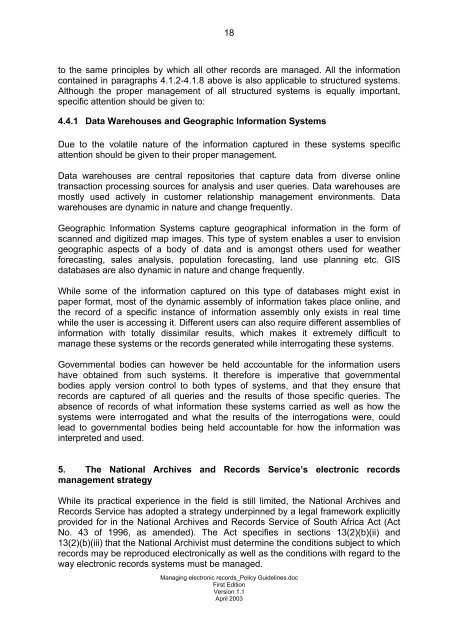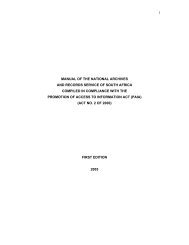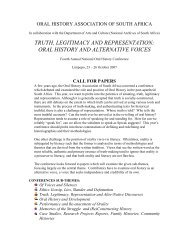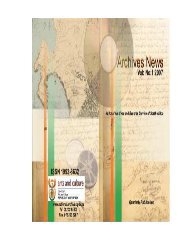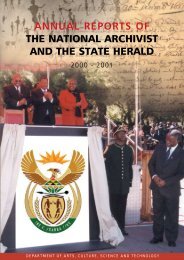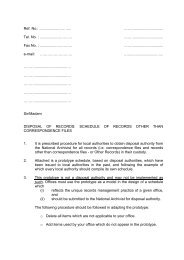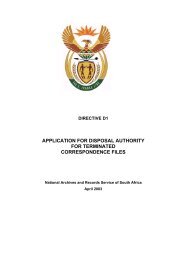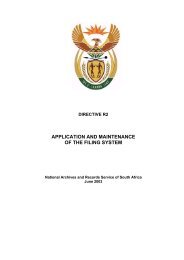managing electronic records in governmental bodies - National ...
managing electronic records in governmental bodies - National ...
managing electronic records in governmental bodies - National ...
You also want an ePaper? Increase the reach of your titles
YUMPU automatically turns print PDFs into web optimized ePapers that Google loves.
18<br />
to the same pr<strong>in</strong>ciples by which all other <strong>records</strong> are managed. All the <strong>in</strong>formation<br />
conta<strong>in</strong>ed <strong>in</strong> paragraphs 4.1.2-4.1.8 above is also applicable to structured systems.<br />
Although the proper management of all structured systems is equally important,<br />
specific attention should be given to:<br />
4.4.1 Data Warehouses and Geographic Information Systems<br />
Due to the volatile nature of the <strong>in</strong>formation captured <strong>in</strong> these systems specific<br />
attention should be given to their proper management.<br />
Data warehouses are central repositories that capture data from diverse onl<strong>in</strong>e<br />
transaction process<strong>in</strong>g sources for analysis and user queries. Data warehouses are<br />
mostly used actively <strong>in</strong> customer relationship management environments. Data<br />
warehouses are dynamic <strong>in</strong> nature and change frequently.<br />
Geographic Information Systems capture geographical <strong>in</strong>formation <strong>in</strong> the form of<br />
scanned and digitized map images. This type of system enables a user to envision<br />
geographic aspects of a body of data and is amongst others used for weather<br />
forecast<strong>in</strong>g, sales analysis, population forecast<strong>in</strong>g, land use plann<strong>in</strong>g etc. GIS<br />
databases are also dynamic <strong>in</strong> nature and change frequently.<br />
While some of the <strong>in</strong>formation captured on this type of databases might exist <strong>in</strong><br />
paper format, most of the dynamic assembly of <strong>in</strong>formation takes place onl<strong>in</strong>e, and<br />
the record of a specific <strong>in</strong>stance of <strong>in</strong>formation assembly only exists <strong>in</strong> real time<br />
while the user is access<strong>in</strong>g it. Different users can also require different assemblies of<br />
<strong>in</strong>formation with totally dissimilar results, which makes it extremely difficult to<br />
manage these systems or the <strong>records</strong> generated while <strong>in</strong>terrogat<strong>in</strong>g these systems.<br />
Governmental <strong>bodies</strong> can however be held accountable for the <strong>in</strong>formation users<br />
have obta<strong>in</strong>ed from such systems. It therefore is imperative that <strong>governmental</strong><br />
<strong>bodies</strong> apply version control to both types of systems, and that they ensure that<br />
<strong>records</strong> are captured of all queries and the results of those specific queries. The<br />
absence of <strong>records</strong> of what <strong>in</strong>formation these systems carried as well as how the<br />
systems were <strong>in</strong>terrogated and what the results of the <strong>in</strong>terrogations were, could<br />
lead to <strong>governmental</strong> <strong>bodies</strong> be<strong>in</strong>g held accountable for how the <strong>in</strong>formation was<br />
<strong>in</strong>terpreted and used.<br />
5. The <strong>National</strong> Archives and Records Service’s <strong>electronic</strong> <strong>records</strong><br />
management strategy<br />
While its practical experience <strong>in</strong> the field is still limited, the <strong>National</strong> Archives and<br />
Records Service has adopted a strategy underp<strong>in</strong>ned by a legal framework explicitly<br />
provided for <strong>in</strong> the <strong>National</strong> Archives and Records Service of South Africa Act (Act<br />
No. 43 of 1996, as amended). The Act specifies <strong>in</strong> sections 13(2)(b)(ii) and<br />
13(2)(b)(iii) that the <strong>National</strong> Archivist must determ<strong>in</strong>e the conditions subject to which<br />
<strong>records</strong> may be reproduced <strong>electronic</strong>ally as well as the conditions with regard to the<br />
way <strong>electronic</strong> <strong>records</strong> systems must be managed.<br />
Manag<strong>in</strong>g <strong>electronic</strong> <strong>records</strong>_Policy Guidel<strong>in</strong>es.doc<br />
First Edition<br />
Version 1.1<br />
April 2003


